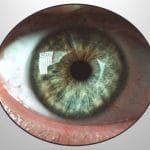All About Anti-Reflective Coating, ARC Lens, Anti-Glare Lens, or ARC Glasses.
Anti-Reflective Coating (ARC Lens) or ARC Glasses
What exactly are anti-reflective coating (ARC) lenses or non-glare coating in eyeglasses, and is it worth it? Today, we will be discussing what this lens enhancement in ARC lenses can do for you as well as doing some comparisons so that you can see the difference.
Let’s get started.

Also known as anti-glare coating, an anti-reflective coating (ARC) lens or anti-reflection coating is a special type of lens enhancement that’s applied to the front and back surfaces of the lens to improve the transmittance of light as it passes through the lens reducing glare and reflections. It also helps to improve the cosmetic appearance of glasses.
Because of the several benefits, you can find anti-reflective coating (ARC) in just about any optical surface extending from glasses to telescopes, cameras, and even binoculars. If you look at the lens surfaces of these devices, you can see a red, green, purple, or even a bluish reflection coming off of those surfaces and that’s anti-reflection.
It helps to reduce the glare and improves the clarity and image of the photograph or video that you may take with that camera lens. You can even pull out your cell phone and check out the camera lens. You could see rainbow shimmer coming off of the lens and that’s anti-reflection.
When you look at any sort of reflective flat surfaces such as a lens, a glass window, or a piece of plastic, you’re likely to see some level of reflection of either yourself or anything that’s going on behind you because of the anti-reflection. It means the light is not passing through that transparent surface completely.
It’s hitting the front surface and some of the light is lost. It actually reflects and bounces away from the lens. Likewise, some light even passes through the front surface, hits the back surface of the lens, and then reflects internally.
Depending on the material that you’re looking through, the reflections can actually decrease the clarity as well as the contrast of the final image that you’re trying to view because not all of the light is allowed to pass through that lens.
Anti-reflective coating (ARC) in sunglasses
The anti-reflective coating (ARC) is even important in sunglasses. If you hold up the sunglasses, on the front surface you can still see a reflection of the light or the window to the side but if you turn it around there is a little bit of the rainbows-like appearance on the back surface of these lenses.
The anti-reflection coating (ARC) is beneficial because when you’re wearing these sunglasses, the coating will prevent any reflections from things behind you and even the picture of your own eye. Otherwise, you will see a reflection of your own eye and that can be really distracting.
If you put on a pair of sunglasses that have an anti-reflective coating (ARC) you can still see some level of the reflections. It’s just not realistic to expect a hundred percent reflection-free sunglasses.
In general, regular plastic lenses reflect around 8 percent of light striking the lens surfaces. So, roughly 92 percent of light enters the eye for visual function. However, some better brands on the market have achieved greater than 99.5 percent of transmittance. It means, virtually there is no reflection at all.
If you’re looking for high-quality anti-reflection coating glasses, you can trust Crizal along with other brands.
History of Anti-Reflective Coating ARC Lens
1886: Lord Rayleigh, a British Nobel prize-winning physicist, discovered natural index-matching coatings. He found that a slightly tarnished glass allowed more light transmittance than a brand new one. This gave rise to the study of a strange phenomenon of “anti-reflection”.
1904: British inventor/optical designer Harold Dennis Taylor of Cooke Company developed a chemical method of producing AR coatings.
In the late 1930s: Katharine Burr Blodgett and Irving Langmuir developed Langmuir-Blodgett films, an organic anti-reflective coating.
1935: Alexander Smakula of Carl Zeiss Optics Company developed interference-based anti-reflective coatings (ARC). (source)
How anti-reflective coating (ARC) is applied?
Anti-reflective coating in the ARC lens is applied by the use of highly sophisticated vacuum deposition technology. For this, the lenses are cleaned and inspected for any microscopic surface defects. It involves multiple washing and rinsing baths, including ultrasonic cleaning to remove any surface contaminants. Then to remove unwanted moisture and gases from the lens surfaces, the lenses are air-dried and heated in special ovens.
The cleaned and dried lenses are then put and rotated into the coating chamber. To create a vacuum, the door of the chamber is sealed, and the air is pumped out of the chamber. The metal oxides are placed in separate compartments and are bombarded by electrons.
This bombardment of metal oxides by electrons vaporizes the coating materials within the chamber. Then the vaporized metal oxides adhere to the surfaces of the lenses creating a uniform, thin optical layer on the ARC lenses.
ARC Lens or ARC Glasses Pros and Cons
Although crystal clear vision and better looks are excellent reasons to think about anti-glare coating in addition to your frames, there are several pros and cons of anti-glare lenses or ARC lenses to think about before you decide to make the investment.
Pros of anti-glare lenses or ARC lens
Add-on to your look
One of the benefits of anti-reflection coating on lenses is cosmetic perks. You’ll look better when you use AR coatings because people will see your eyes rather than the annoying reflections from the lenses. As a consequence, you’ll have enhanced eye contact with others during conversation. It’s the perfect opportunity for those who make a lot of public appearances as you will appear to be more photogenic.
Improved vision
In comparison to the uncoated lens, the anti-glare lens or ARC lens offers you a visual quality that is clearer, and sharper. With anti-reflective lenses, you will see the colors of any objects that are closer to their natural condition. It enhances the way you see the world by allowing more light to pass through the lens while eliminating the glare. So, you can experience clear vision everywhere.
Extend the life of the lenses
The anti-reflection coating is exceptionally resistant to scratches and common elements of damage that occur every day for eyeglasses wearers. So, the lenses will run for a long time with any frame as compared to standard uncoated lenses. They are also good for resisting both dirt and water to keep your view clear.
Reduce eye fatigue at work
The lenses with an anti-reflective coating reduce the eye strain and fatigue that your eyes encounter when staring at any gadget screen for a long time. Reflection from a blue light spectrum is particularly bothersome to some users. So, these anti-reflective lenses cut the glare and some amount of harmful blue rays, thus minimizing ocular fatigue.
Improves night vision
Anti-reflective coating reduces the glare and haloes seen at night when bright lights are present in the surrounding. Instead of a halo effect, you can perceive pure natural color and improved contrast of objects at night which is crucial for nighttime driving, cycling, or walking.
Cons of anti-glare lenses or ARC lens
Anti-reflective coatings in lenses have the following drawbacks:
- ARC lenses look dirty due to the clarity of the lenses. Although they are not dirtier than uncoated lenses, they are more noticeable due to the lack of glare to hide the dirt.
- They do not resist extreme temperatures. The coatings get damaged when it encounters situations where you are near either fire or ice. The low-quality coating can bubble or peel when you are close to extreme heat or cold.
- You will damage the coated lens if you clean it with dry clothes frequently.
- Anti-reflective coating (ARC) is not available in contact lenses. So, this is a problem for the contact lens wearer.
Popular AR coating Lens Brands in the USA
Zeiss: Teflon Clear Coat, Carat Advantage
Essilor Brand: Crizal Alize, Crizal Avance, Crizal Sapphire 360UV
Hoya: Hi-Vision, Super Hi-Vision with View Protect
Caring of ARC Lens in Eyeglasses
Lens cleaners with strong chemicals can damage the coating. So, always use only products that are recommended by the optician. Likewise, fine scratches are more visible on anti-reflection coated lenses than on uncoated lenses. To prevent lenses from scratches, always clean the ARC lens by wetting them first because a dry cloth on a dry lens can scratch the lens.
Frequently Asked Questions and Answers
Here are ten frequently asked questions and answers about anti-reflection glasses or AR coating glasses:
1) What are anti-reflection glasses, and how do they work?
Anti-reflection (AR) glasses have a special coating applied to the lenses that reduces the amount of glare and reflections on the surface of the lens. This coating helps to improve vision clarity and reduce eye strain.
2) How do AR coatings benefit people who wear glasses?
AR coatings benefit those who wear glasses by reducing the glare and reflections on the lenses, which can cause eye strain and fatigue. This, in turn, helps to improve visual acuity, especially in low-light conditions.
3) Can anyone wear AR glasses, or are they only for certain types of prescriptions?
AR glasses can be worn by anyone, regardless of their prescription. They can be particularly beneficial for people who wear high-index lenses or progressive lenses, as these types of lenses can produce more reflections and glare than standard lenses.
4) Are AR glasses more expensive than regular glasses?
AR glasses are typically more expensive than regular glasses due to the additional cost of the coating. However, the benefits of improved vision and reduced eye strain may be worth the extra cost for many people.
5) How do I clean my AR glasses?
To clean AR glasses, use a microfiber cloth or lens cleaning solution specifically designed for AR coatings. Avoid using paper towels, rough cloths, or other materials that can scratch the coating.
6) Will the AR coating wear off over time?
With proper care, AR coatings should last the lifetime of the glasses. However, some wear and tear may occur over time, especially if the glasses are not cleaned properly or if they are exposed to harsh chemicals or environments.
7) Can I get AR coatings on sunglasses?
Yes, AR coatings can be applied to sunglasses, and they can be particularly beneficial for reducing glare and reflections when driving or spending time outdoors.
8) Can I get AR coatings on only one lens of my glasses?
Yes, AR coatings can be applied to one or both lenses of your glasses. However, it is recommended to apply the coating to both lenses to achieve maximum benefit.
9) Will AR coatings make my lenses more prone to scratching?
AR coatings can make lenses more prone to scratching if they are not properly cared for. However, if you clean and handle your glasses carefully, the coating should not significantly increase the likelihood of scratches.
10) Can I apply an AR coating to my existing glasses, or do I need to purchase new ones?
In most cases, an AR coating can be applied to existing glasses. However, it is important to check with your eye care provider to ensure that your lenses are compatible with the coating and to determine if the coating can be applied without compromising the quality of your lenses.






